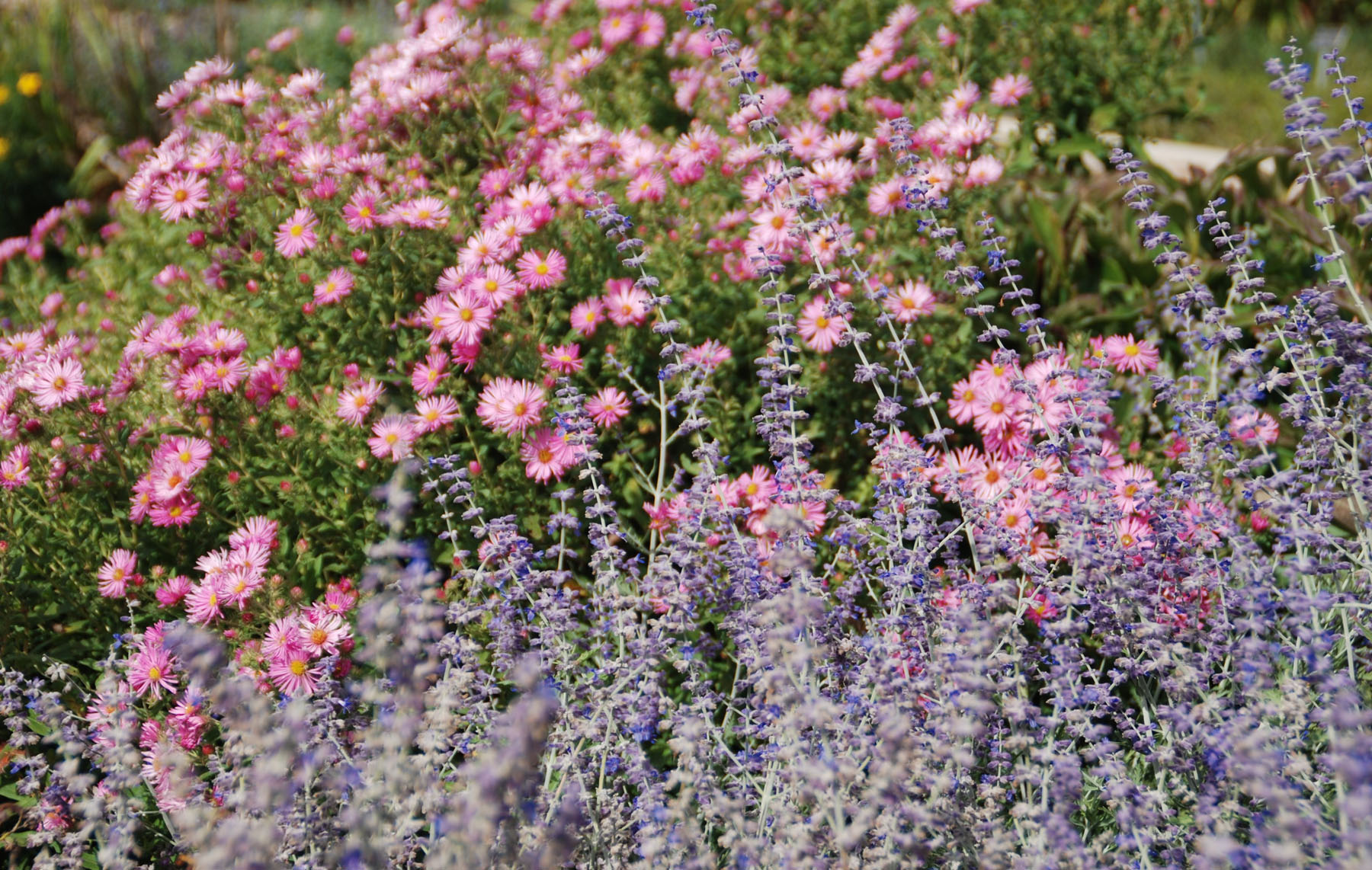
Gardening
Cutting and Enjoying Fall Perennial Flowers

Honeysong Pink Aster (Aster novae-angliae 'Honeysong Pink') combined with Russian sage (Perovskia atriplicifolia) works well in cut floral arrangements.
Photo courtesy of MelindaMyers.com
Bring a bit of your fall garden indoors. Many of your fall flowering perennials make great cut flowers to enjoy in arrangements for your home and bouquets to share with others.
Harvest your flowers early in the morning whenever possible. This is when they are fully hydrated, helping to extend their vase life. Early evening is the next best time, but any time you need to cut your flowers will work.
Take along a clean bucket of water and a sharp pair of bypass pruners or snips to the garden. Immediately place the flowers in the water to help prolong their vase life.
Picking flowers at the right stage for the variety you are cutting is important to ensure the flowers showcase their best display and will last the longest in your arrangements. In general, spike-type flowers should be harvested when one-fourth to one-half of the individual flowers on the spike are open. Daisy-type flowers like rudbeckias, coneflowers, Heliopsis and Helenium are harvested when the flowers are fully open.
Asters and golden rods make a great combination in the garden as well as a vase. Harvest the golden rod as soon as the flower color is visible with half of the individual flowers in the cluster open. Look for and pick asters when one-fourth of the flowers in the cluster are open to enjoy them for as many as 7 to 12 days.
The native Agastache, you may know as lavender or anise hyssop, is a pollinator favorite and makes an excellent addition to flower arrangements. Wait for one-half to two-thirds of the flowers on the spike to open before picking. With proper harvesting and care, these flowers can last 6 to 10 days in your arrangement.
Watch as the individual flowers on the Liatris spike open from the top down. Harvest these when less than half of the flowers at the top of the spike are open and the remainder are in bud.
Once rudbeckias and coneflowers shed their petals, which are actually non-fertile ray flowers, the remaining seed heads still make an attractive addition to fall bouquets. Don't overlook the wispy seed heads and foliage of ornamental and native grasses growing in the garden. These can be harvested at any time after the seed head emerges and last about a week.
Consider adding a few seed pods for added fall flare in your bouquets. The pods of native baptisia and milkweed as well as Siberian iris are a few to try.
Condition fresh flowers before arranging to further extend their vase life. Set the flowers in tepid water and place them in a cool place out of direct sunlight for at least several hours and preferably overnight before arranging.
Recut the stems on a 45º angle to the desired length when creating your arrangements. The angled cut prevents stems from sitting flat on the bottom of the vase, exposing more surface area to absorb water. Remove the lower leaves that would otherwise end up submerged in the water in the vase. Foliage in the water encourages microbial growth that can shorten the vase life of your cut flowers.
Always use a clean vase filled with fresh water. Add a floral preservative to the water to further extend the vase life of your flowers. Change the water often to keep flowers looking good for as long as possible. Remove individual flower stems as they fade and rearrange the remaining ones that still look fresh. Recut the stems as needed to keep the flowers absorbing water and lasting longer.
Add your own perennial flower favorites and evaluate how they perform as cut flowers. Make a few notes on those that worked well and do a bit of research to improve the vase life of those that did not. Even a short-lived arrangement will generate a smile and brighten your mood when bringing a bit of your garden indoors.
Melinda Myers has written more than 20 gardening books, including The Midwest Gardener's Handbook, 2nd Edition and Small Space Gardening. She hosts The Great Courses "How to Grow Anything" DVD series and the nationally-syndicated Melinda's Garden Moment TV & radio program. Myers is a columnist and contributing editor for Birds & Blooms magazine. Her web site is www.MelindaMyers.com.
Antiques
Latest Auction News

Photo courtesy of Wayne Tuiskula
This week's news stories all feature a European connection. We'll start in England where the auction of a Henry VIII document began last week. It was written by Henry VIII over 500 years ago, according to Great Britian's ITV News. Henry VIII instructed the keeper of his wardrobe, Sir Andrew Windsor, to supply cloth to make into gowns. A well-known British antiques dealer purchased the piece from another dealer a few years ago. He has seen more interest in Henry VIII in recent years resulting in increasing values for his memorabilia. The document is being sold in England in a "Dutch auction." The bidding starts at £65,000 (~$79,559.93 U.S.). A Dutch auction means the price is lowered each day until someone buys it. It can be a test of nerves for serious collectors to see how low they will let it drop knowing that another bidder could own it at any point.
Also in England, an online auction of over 1,800 pieces of film and movie memorabilia started this week in London, according to the Robb Report. Bidders will have the opportunity to purchase the overcoat worn by Marlon Brando in 1972's The Godfather, Leonardo DiCaprio's Titanic outfit, and the sneakers Tom Hanks wore when he portrayed Forrest Gump. Other auction highlights include the tan shirt Harrison Ford wore in Raiders of the Lost Ark, which has an auction estimate of $172,500 to $345,000. The metal glove that Freddy Krueger wore in A Nightmare on Elm Street is estimated at $230,000 to $460,000. A C-3PO head from Star Wars: Episode IV is expected to fetch the highest selling price, estimated between $575,000 and $1.1 million. The auction is expected to gross around $14 million dollars.
An auction of items collected by the Rothschild family will be going up for sale this month, according to the New York Post. The Rothschild family origins date back to the Frankfurt, Germany Jewish ghetto in 1450. By the mid-19th century, the family collectively had one of the largest fortunes in the world, according to the Rothschild family archive (rothschildarchive.org). Although the family accumulated their wealth in Europe, the auction will take place in New York. I've mentioned in previous columns that many traditional antiques have dropped in value, but that doesn't apply to the Rothschild family collection. A group of porcelain tureens has a $30,000 to $50,000 auction estimate. A pair of late Louis XV fauteuils (type of open armchairs) is estimated to bring $600,000 to $1 million. Some gilded leather panels by a follower of Rembrandt are expected to bring around $1.5 million. A 17th century painting titled "A young woman holding a hare with a boy at a window" has a $3 to $5 million estimate. Some items start at only $100 so even an average person can collect like a Rothschild family member.
It was nice to meet a few regular readers of this column at my "Evaluating your Antiques" class last week. Our toy and comic book online auction will begin this week. Our next major multi-estate auction including art, sterling silver, and a wide variety of antiques and collectibles starts next month. We are still accepting coins and other consignments for that auction. Please visit our website www.centralmassauctions.com for links to upcoming events.
Contact us at: Wayne Tuiskula Auctioneer/Appraiser Central Mass Auctions for Antique, Collectibles Auctions and Appraisal Services www.centralmassauctions.com (508-612-6111).
Contact us at: Wayne Tuiskula Auctioneer/Appraiser Central Mass Auctions for Antique, Collectibles Auctions and Appraisal Services www.centralmassauctions.com (508-612- 6111).